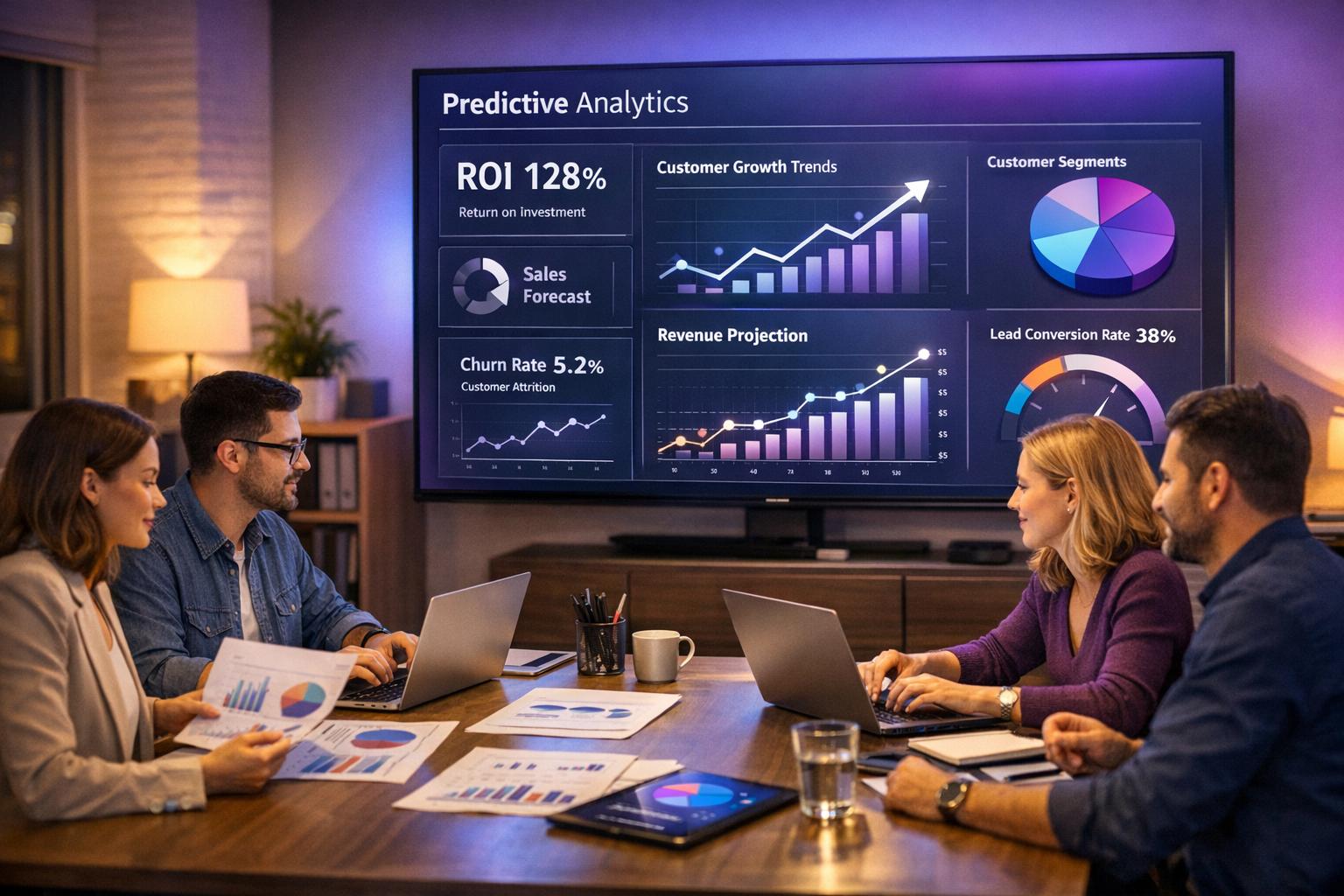ai-automation-can-help-marketing-agencies-cut-costs-by-up-to-80percent-while-maintaining-high-quality-services-heres-how
- Automated Campaign Management: Reduces manual work, optimizes ad budgets, and saves on reporting costs.
- Streamlined Lead Generation: Automates lead scoring and personalization, cutting research and qualification time by up to 70%.
- Optimized Resource Allocation: Uses data to improve staff efficiency, campaign ROI, and content production costs.
- Improved Customer Engagement: AI tools like chatbots and predictive analytics lower support expenses and improve targeting.
- Scalable White-Label AI Solutions: Saves up to 80% in development and maintenance costs compared to in-house systems.
Quick Overview
| Area | Savings | Key Benefit |
|---|---|---|
| Campaign Management | 30-40% fewer manual tasks | Real-time adjustments and tracking |
| Lead Generation | Up to 50% lower costs | Automated lead scoring and filtering |
| Resource Allocation | 20-30% better efficiency | Data-driven decisions |
| Customer Engagement | 40% drop in support costs | 24/7 automated support |
| White-Label AI Solutions | Up to 80% cost savings | Scalable, ready-to-use platforms |
Related video from YouTube
AI Automation's Impact on Marketing Agencies
AI automation is reshaping how marketing agencies operate, bringing new levels of efficiency and effectiveness. It has moved beyond simple tasks to managing more complex operations, freeing up human teams to focus on strategic work that delivers better results for clients.
Thanks to the availability of AI tools, agencies of all sizes can now access advanced marketing solutions. White-label AI platforms, in particular, stand out by enabling agencies to offer high-level services without needing heavy investments in infrastructure. Here's a snapshot of how these platforms help agencies save time and money:
| Capability | Cost-Saving Impact |
|---|---|
| Automated Campaign Management | Cuts down manual work |
| Data Analysis & Reporting | Speeds up decision-making |
| Customer Engagement Tools | Lowers support expenses |
| Content Creation Automation | Boosts production speed |
Chet Kapoor, CEO of DataStax, highlights this potential: > "AI can boost your income, trim expenses, and deliver a strong ROI". Tools like automated campaign management and customer engagement platforms clearly back up this claim.
But the benefits of AI automation go beyond just cutting costs. By using AI for tasks like predictive analytics and understanding customer behavior, agencies can make smarter choices about where to allocate resources and how to shape their campaigns. This data-driven approach reduces waste and ensures marketing budgets are used as effectively as possible.
Modern AI platforms also provide tools that can adapt to changing market conditions. Their scalability means agencies can meet growing client demands without needing additional infrastructure. This ability to evolve with market needs makes AI a game-changer, particularly when looking at specific applications like automated campaign management.
1. Automated Campaign Management
AI-powered tools are transforming how marketing agencies handle campaigns, offering a way to cut costs and boost efficiency. With white-label solutions, agencies can integrate advanced tools directly into their operations without the need for expensive in-house development.
These modern AI platforms simplify key campaign tasks, delivering savings in three main areas:
| Campaign Aspect | AI Automation Benefit | Cost-Saving Impact |
|---|---|---|
| Data Analysis | Real-time performance tracking | Cuts out manual reporting expenses |
| Content Optimization | Automated SEO and content tweaks | Lowers content management costs |
| Ad Management | Real-time budget adjustments | Maximizes ad spend efficiency |
For example, InnovaAI’s white-label platform automates tasks like performance tracking, budget management, content updates, and A/B testing. This allows agencies to simplify workflows and save money.
To get the most out of AI-driven tools, agencies should first identify the tasks that consume the most time and resources. Focusing on these areas ensures the best return on investment while maintaining campaign quality.
AI doesn’t just save time - it also improves results. With predictive capabilities, it helps agencies avoid unnecessary spending and make smarter use of their budgets. Machine learning algorithms take this further by enabling highly personalized campaigns, cutting down on manual work.
But campaign management is just the beginning. AI also holds the key to making lead generation processes more efficient.
2. Streamlined Lead Generation
AI is reshaping how marketing agencies approach lead generation, cutting costs and boosting efficiency through automation. With AI-powered tools, agencies can minimize manual work while improving the quality of leads.
Here’s how AI makes an impact:
| Feature | Cost Savings |
|---|---|
| Data Analysis | Cuts research costs by 60-70% |
| Lead Scoring | Reduces qualification time by 40% |
| Personalization | Lowers content creation costs by 30% |
These tools simplify workflows by automating tasks like lead scoring and qualification. Additional features, such as multilingual support and CRM integration, make scaling operations more affordable by reducing the need for extra staff.
To get the most out of AI, agencies should prioritize clean, well-organized data, ensure smooth integration with their current platforms, and invest in staff training.
While AI takes care of repetitive tasks, human expertise is still essential for building relationships and making complex decisions. AI can predict which leads are most likely to convert, allowing teams to focus their efforts where it matters most. By automating routine work, agencies not only save money but also stay agile in a fast-changing market.
3. Optimized Resource Allocation
AI is transforming how marketing agencies manage their resources, enabling smarter, data-driven decisions that cut costs and boost efficiency. By processing massive datasets, AI pinpoints areas where resources are underutilized or wasted, leading to measurable savings.
Here’s a breakdown of how AI improves resource use:
| Resource Type | AI Solution | Cost Impact |
|---|---|---|
| Staff Time | Workflow Automation | Cuts manual work by 30-40% |
| Campaign Budget | Predictive Analytics | Increases ROI by 15-25% |
| Content Creation | Content AI | Lowers production costs by 40% |
| Customer Support | Chat Automation | Reduces support costs by 60% |
AI’s predictive tools allow agencies to allocate resources more effectively. For example, analytics can identify the most profitable channels, enabling smarter budget distribution. This eliminates guesswork and avoids wasting money on low-performing campaigns.
To get the most out of AI-driven resource allocation:
- Integrate Performance Tracking: Combine data from multiple tools and monitor KPIs to measure AI’s impact.
- Upskill Your Team: Train staff to use AI tools effectively, ensuring they can adapt to new workflows.
Choosing the right AI tools is essential. Modern platforms offer features like automated workflows and AI-powered content creation, which can be tailored to meet an agency’s specific goals.
While optimizing resources is a major benefit, AI’s role in improving customer engagement is equally important - more on that next.
4. Improved Customer Engagement
AI tools are changing how businesses connect with customers, allowing agencies to create tailored interactions, predict customer needs, and save money in the process.
AI-powered engagement can cut costs by 10-19% across various areas:
| Engagement Area | AI Solution | Benefit |
|---|---|---|
| Customer Support | AI Chatbots | Around-the-clock service |
| Campaign Personalization | Predictive Tools | Lower advertising costs |
| Content Distribution | Smart Scheduling | Increased engagement |
| Lead Nurturing | Automated Follow-ups | Reduced acquisition expenses |
How Marketing Agencies Are Using AI
Agencies leveraging AI tools report measurable savings while improving customer experiences. Here's how they do it:
- AI Chatbots: Provide 24/7 customer support, reducing the need for large support teams.
- Predictive Tools: Target campaigns more effectively, cutting unnecessary ad spend.
- Content Optimization: Use AI-driven tools to refine and distribute content for maximum impact.
The Power of Personalization
AI examines customer behavior to craft campaigns that resonate. By identifying the best channels and timing for communication, agencies can boost engagement and lower acquisition costs. This data-driven approach ensures every interaction feels relevant to the customer.
White-Label AI Solutions for Scaling
For agencies aiming to grow, white-label AI platforms offer a practical solution. These tools can be customized for individual clients while keeping operations streamlined.
The biggest savings come from AI's ability to:
- Automate repetitive tasks like customer inquiries.
- Predict future customer actions to stay ahead.
- Fine-tune campaigns for the right audience at the right time.
- Expand personalization efforts without needing additional staff.
AI not only enhances engagement but also provides agencies with scalable, efficient tools to broaden their offerings without breaking the bank.
5. Scalable White-Label AI Solutions
White-label AI solutions are a smart way for marketing agencies to expand their services without heavy investments in infrastructure.
Affordable and Efficient
Using white-label AI platforms can save agencies up to 80% compared to building in-house systems. Here's how the costs break down:
| Cost Category | Traditional Approach | White-Label Solution | Potential Savings |
|---|---|---|---|
| Development | $100,000+ upfront | Monthly subscription | Up to 80% |
| Maintenance | Dedicated team required | Included in service | 60-70% |
| Scaling | Additional infrastructure | Built-in scalability | 40-50% |
| Training | Extensive staff training | Pre-built tutorials and intuitive interfaces | 30-40% |
Smarter Tools, Better Results
Platforms like InnovaAI bring a range of tools that help agencies deliver better results with less effort:
- AI-driven lead generation to cut down on manual prospecting.
- Automated campaign optimization for higher ROI.
- Multi-language capabilities to tap into global markets.
- Custom dashboards tailored for client-specific needs.
Streamlined Operations
White-label AI solutions automate tasks like content creation, customer support, campaign analysis, and lead scoring. This not only saves time but also ensures consistent quality while lowering operational expenses.
Perks of Partnering with Providers
Partnering with white-label AI providers comes with several built-in advantages:
- Regular platform updates at no extra cost.
- Scalable infrastructure that adjusts to your needs.
- Technical support and maintenance included in the subscription.
- Advanced analytics and reporting tools for better decision-making.
Choosing the right white-label solution means finding one that aligns with your agency's goals while offering the flexibility to meet client demands. By adopting these tools, agencies can cut costs and stay competitive in an ever-changing market.
Conclusion
AI automation provides marketing agencies with powerful tools to cut costs and improve efficiency. By automating tasks like campaign management, lead generation, resource allocation, and customer engagement, agencies can lower expenses while maintaining top-tier service.
White-label AI tools, in particular, offer a practical way for agencies to boost performance across critical areas:
| Benefit Area | Cost Impact | Operational Advantage |
|---|---|---|
| Campaign Management | 30-40% fewer manual tasks | Real-time adjustments and tracking |
| Lead Generation | Up to 50% lower acquisition costs | Automated lead scoring and filtering |
| Resource Allocation | 20-30% better efficiency | Decisions backed by data insights |
| Customer Engagement | 40% drop in support costs | Around-the-clock automated support |
These white-label platforms come with features like scalability, ongoing technical support, and regular updates, making them easier to manage. For agencies looking to adopt AI, platforms such as InnovaAI allow for a gradual and flexible shift to AI-driven operations, minimizing disruption while maximizing benefits.


